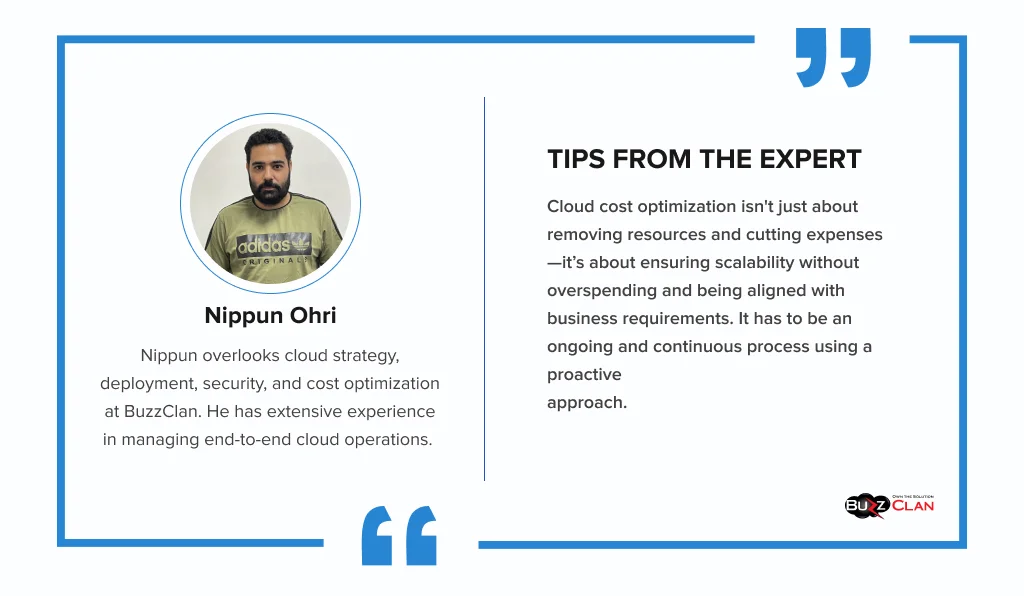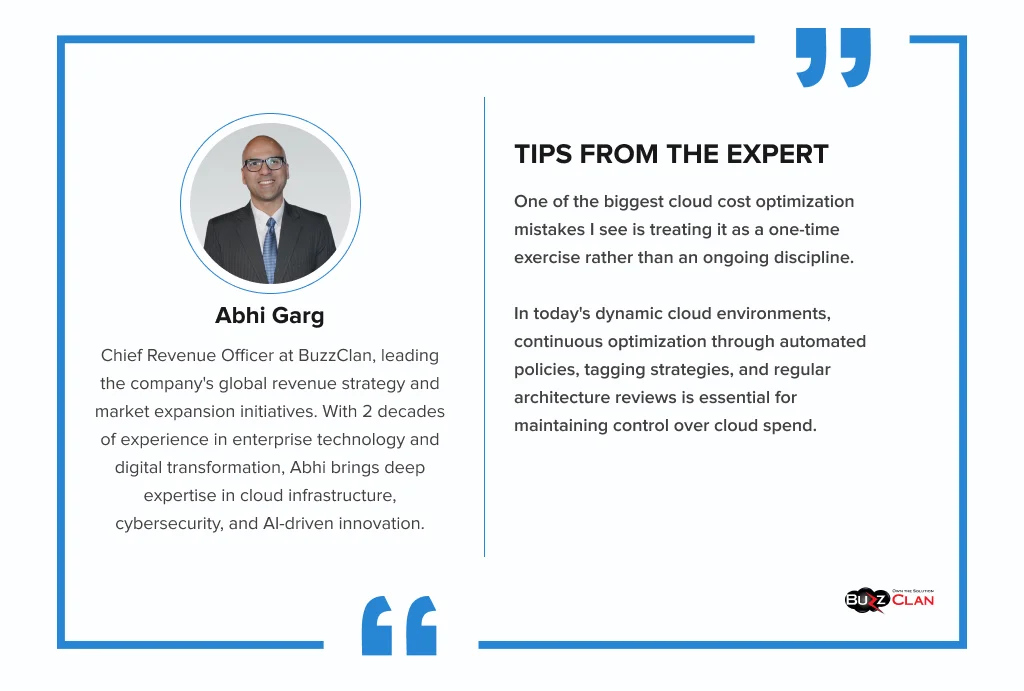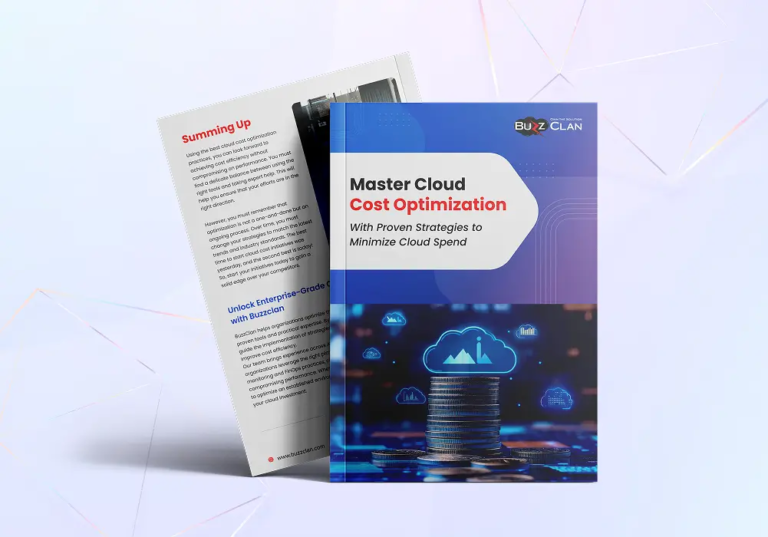Cloud Cost Optimization: 15 Proven Strategies to Cut Cloud Spend in 2025
Vaibhav Gramni
Jul 11, 2025
What Is Cloud Cost Optimization?
Simply put, cloud cost optimization is a part of cloud financial management or FinOps. Using cloud cost optimization best practices, businesses can reduce their cloud spending without compromising performance. However, you are mistaken if you think it is just about cutting costs. Cloud cost optimization uses tools, techniques, and analysis to help you pinpoint where resources are underutilized. You get a transparent picture of your cloud usage, enabling you to take the right direction quickly. The focus lies on eliminating waste and establishing a smooth tandem between security, cost, performance, and availability.
Why Does Cloud Cost Optimization Matter?
Just like your health, the cloud ecosystem’s health needs to be nourished. When the virtual machines work just fine without pressure (not overused), you can look forward to improved performance. Well, virtualization helps you create multiple environments, which, if not used efficiently, can create havoc with cloud costs. The same is the case with cloud storage. Enter cloud cost optimization. It will help you reduce your expenditure, gain control over your budget, and predict future costs with cost analysis. This way, not only will resources be used with enhanced efficiency, but you will also gain a competitive advantage.

Importance of Monitoring Cloud Costs
Cloud cost optimization will help you maximize most of your cloud computing initiatives. From identifying opportunities to maximizing the value of your resources, the sky is the limit when your cloud costs are appropriately managed. The right tools and techniques will help you automate the process by setting triggers. This way, you can save time and money in the long run and reduce security risks. If achieving business objectives with zero overspends is your motto, consider it fulfilled with cloud cost optimization.
Cloud Cost Allocation in Multi-Cloud Environments
Allocating costs accurately is crucial for financial transparency in multi-cloud environments. Cloud cost allocation involves distributing expenses across departments, projects, or teams. For the same, you need tools that will help to enable tagging resources for precise chargeback and showback. This will ensure each stakeholder is accountable for their cloud usage.
Understanding Cloud Billing & Cost Components
Before we jump into the cloud billing and cost components, you need to ask yourselves a few questions, and these include:
- How high are your cloud costs?
- How are the cloud costs impacted when a client is added?
- What cloud features add to extra costs?
- What are the expected issues if a cost optimization is done?
If you don’t have answers to these questions, it is time to have a solid discussion with your cloud providers. With detailed billing, reports, and dashboards, you will know precisely about the over-provisioned instances and how inefficient your cloud storage is. Also, check if you have a defined cloud budget for all departments in your organization. The process known as tagging will only help you track better and allocate costs better.
Now, let’s understand the various components that add to your cloud bill.
Compute Costs
The whole idea of the cloud depends on virtual machines and serverless computing. The type, size, and machine duration will broadly impact your costs. You can discuss suitable pricing options with your cloud providers. If you demand flexibility, then on-demand pricing is ideal. For long-term savings, reserved instances are a good choice. You can reserve them for a defined time frame and release them when not required. At the same time, spot instances can handle temporary workloads at discounted rates. We will be discussing them more in the upcoming section.
Licensing Costs
Dealing with third-party services means shelling out money for licensing costs. The charges are based on consumption, user numbers, or features. Thus, learning about licensing agreements and how they impact your bottom line is essential. While some cloud providers may let you bring your software licenses, you must optimize software usage and look for open-source alternatives.
Data Transfer Cost
Data can be transferred within and across cloud environments. While you can quickly transfer data internally, outbound data transfer incurs some fees depending on the volume of the data and the distance. So, to keep control of your cloud costs, you will need to analyze data transfer patterns and manage them to reduce expenses. Often, cloud providers charge transfer fees for some regions and offer free or subsidized data transfer for other areas.
Storage Costs
Another cost on our list to be considered is the storage cost. How frequently do you access your data, how long is it retained, plus block storage impact your cloud costs? While block storage is used for virtual machines, and you are charged per gigabyte, object storage is billed based on the data size and access frequency. A wise idea is to store less-used data in object storage. Another thing you should consider is that moving data within storage services can add up to costs. So, ensure all your cloud operations are carefully planned when you look forward to cloud cost optimization.
Additional Costs
It is time to talk about additional costs associated with cloud computing. Beyond the fundamental and apparent charges, you must also consider disaster recovery and backups. If you are taking any premium services, they must also be accounted for. These include data transformation, analytics, and machine learning capabilities. Lastly, the cost associated with security measures, regulatory compliance, and integration with external systems will also add to cloud costs.
Further Reading
Cloud Pricing Models
Before optimizing cloud costs, you must talk with your cloud service provider. They will help you pick the best pricing model based on your workload requirements. While each model has advantages, not all are suitable for your business. Let’s have a look at them one by one.
On-demand Pricing
This is the simplest and most chosen option by businesses. In this model, you only pay for the resources you use. However, the pricing structures vary from one provider to another. While some charge by the hour, some go granular charging per second. The good part is that virtual machines are available as needed and can be scaled up and down, and there is no long-term commitment. This pricing model is ideal if you wish to have ample flexibility and need to handle periodic spikes.
Pay-As-You-Go Pricing Model
As the name suggests, you pay for the resources you consume. This model offers businesses the best scalability and cost-effectiveness, making it ideal for startups and small companies, as they must deal with unpredictable workloads more often.
Spot Pricing
Well, this pricing is available based on auctions. You can bid for instances as their market price drops. However, this will require you to pay a lot of attention to the prices and can lead to unnecessary waits. Drop the thought of this price mode if you need to handle urgent workloads. We say this because the cloud provider can terminate these instances anytime, and you will only receive the information on short notice. The ideal way is to combine it with on-demand instances.
Reserved Instance Pricing
These pricing models require intense commitment on the part of your organization. Only if you commit to a more extended period, say 1-3 years, can you consider saving on cloud costs. In simple terms, choose this model if you are not keen on flexibility. New instances are introduced in the market now and then as the cloud market changes fast. Plus, you need to pay upfront for these instances. So, be very careful before plunging into this cloud pricing model.

15 Cloud Cost Optimization Strategies
Now that you know the best cloud pricing models and bills, it is time to learn about the best cloud cost optimization strategies.
Analyze Cloud Bills
Thoroughness goes a long way, and the same goes for cloud cost optimization. You need to be thorough with your cloud bills and know each aspect. While looking at the final amount and forwarding it to your finance team is tempting, this is not the best practice. We discussed cloud billing and components in the previous section. Taking note of them will help you sail through murky waters with ease.
Identify Unused Resources and Storage
You must know the unused resources in the cloud like the back of your hand. However, if you are unaware, it is time to get going. You can use tools to get the exact picture; the same goes for storage.
Inefficiency never brought any good. If you are not managing cloud storage, it will only lead to wastage. A classic example is retaining old backups on expensive storage tiers. However, you don’t need to waste your precious organizational funds on the same. Top cloud providers like AWS S3 and Google Cloud offer multiple storage classes. Not only are they more affordable for non-critical data, but you can also reduce overall storage costs with them.
Select The Right Cloud Provider
The basics never fail to do wonders. The same is the case when selecting the right cloud provider. Make sure you thoroughly analyze and choose a provider that offers maximum flexibility. If they provide you with a savings plan, then nothing like it! You heard that right!
Savings. Yes, the word evokes different emotions. Luckily, a savings plan protects you in the cloud as well. Many cloud providers offer reserved instances and savings plans with great discounts for fulfilling long-term commitments. If your business has predictable workloads, you can reduce cloud costs by a considerable margin.
Multi-Cloud Strategy to Rescue
The more, the merrier when it comes to cloud cost optimization. Yes, it sounds contradictory. However, when you spread workloads across different cloud providers, you can leverage the best of both worlds. With hybrid and multi-cloud environments, you can get competitive pricing and ensure better security for your environments.
Use Real-time Analytics
Transparency and continuous monitoring can help cut costs by 15-20%—we don’t say McKinsey does! The best way is to use cost management tools, which provide much-needed visibility into cloud spending. When you can identify idle or unused resources, you can choose to release them or better use them.
Set Budgets
This strategy ensures that all your teams know about your goals and budgets. You need to define a monthly budget for your cloud computing strategy. You can take trial and enterprise plans from cloud providers to see what fits best and then plan your usage. Once you have considered all aspects, getting all the teams on the same page will be easy.
Use Cloud Native Design
What if you could use cloud-specific capabilities to your advantage? Cloud-native design helps you do that and much more! You can reduce cloud costs and enjoy balanced performance and robust cloud architectures.
Rightsizing and Using Spot Instances
Adjustments go a long way! This fact holds for cloud costs, too. Let’s clear the air. You need to adjust virtual machines’ capacity and storage, or rightsize them to match your actual usage. This way, you will not waste any resources and can use the existing ones to their best advantage.
Another way to cut cloud costs is to use spot instances. They are your saviors when it comes to cloud cost optimization. But what purpose do they serve? Well, it refers to spare computing capacity offered by cloud providers and is available at a lower cost than on-demand virtual machines. Spot instances can come in handy if you regularly deal with flexible workloads.
Automate, Automate, Automate
You seldom go wrong with automation! Yes, and you must consider auto-scaling your cloud resources based on demand. When your website experiences heavy traffic, using auto-scaling, you can spin up additional resources and release them when they are not needed. Even companies like Uber use auto-scaling to ensure they don’t pay for unused capacity. When are you jumping on the train? Trust us; you will reap manifold benefits.
Consistency Is The Key
You are mistaken if you think cloud cost optimization is a one-and-done process. You must check all the aspects and ensure nothing slips through the cracks. But how do you ensure the same? Well, let’s read what our expert has to say.
Terraform & IaC Cost Controls for Budget Management
Infrastructure as Code (IaC) tools like Terraform can help embed cost controls into deployment pipelines. They can also prevent budget overruns by setting spending limits and leveraging modules for cost estimation. Automating resource shutdowns during off-peak hours also contributes to significant cost savings.
Avoiding Hidden Cloud Costs
Hidden costs in the cloud often result from idle resources, excessive data transfers, and underutilized assets. Follow these practices to avoid these costs.
- Continuous resource monitoring
- Implementing lifecycle policies
- Using reserved instances for predictable workloads.
- Educating teams on cost-aware architecture
Incorporate FinOps
FinOps combines financial management with operational accountability. When you implement the same principles, you can ensure completeness and reduce cost overruns by huge margins. Best practices include:
- Real-time cost tracking
- Regular review cycles,
- Collaborative decision-making
This approach ensures that cost efficiency does not compromise performance or business agility.
Multi-Team Strategies for Cost Accountability
Large enterprises benefit from multi-team strategies that distribute cost accountability. Cross-functional FinOps teams integrate finance, engineering, and operations to optimize spending. This approach ensures continuous improvement in cost efficiency across departments. Thus, you are responsible for training your team. Make sure they are well-versed in all aspects of cloud cost optimization. This will help you find loopholes and take aligned action for improved performance.
Keep A Check On Compliance and Governance
Cost optimization must align with compliance and governance standards. Adhering to data residency laws, maintaining audit trails, and enforcing security policies contribute to financial and legal accountability. But how do you kickstart the whole initiative? For starters, you need to understand governance frameworks like AWS Well-Architected Framework. This will ensure seamless cost management and take care of all security aspects.
Further Reading
Cloud Cost Management vs. Cloud Cost Optimization
Let’s understand the difference between cloud cost management and cloud cost optimization.
| Feature | Cloud Cost Management | Cloud Cost Optimization |
|---|---|---|
| Focus | Tracking, analyzing, and predicting cloud expenses. | Reducing unnecessary cloud expenses through efficiency improvements. |
| Approach | The approach is reactive, as there is a focus on cost visibility and governance. | A proactive approach allows scope for continuous improvement and automation. |
| Key activities | Budgeting, tracking usage, cost reporting, and governance. | Rightsizing, auto-scaling, reserved instances, and eliminating waste. |
| Tools Used | Cost management dashboards and forecasting tools help with cloud cost management. | AI-driven cost optimization tools, automation scripts, and workload analysis are done to optimize cloud costs. |
| Outcome | You can improve cost control and accountability with cloud cost management. | Overall, cloud expenses can be reduced with a boost in performance. |
AI-Driven Cost Optimization in Cloud Platforms
AI-driven tools will help you analyze usage patterns and recommend optimizations. Cloud platforms like AWS, Azure, and GCP are the best available options, offering AI-based insights to right-size resources, forecast demand, and detect anomalies. These capabilities help your organization adjust cloud usage in real time for maximum cost efficiency.
Multi-Cloud and Hybrid Cloud BI Strategies
Managing cloud costs is a significant challenge for businesses. Studies suggest that 30-40% of cloud spending goes to waste. Let’s understand the main challenges and how you can overcome them.
Embedded BI and Self-Service Dashboards
While traditional BI has limitations, modern cloud BI solutions integrate insights and analytics into business applications. Moreover, self-service BI is a boon for non-technical users as they can generate reports without IT support. One example is Salesforce and Tableau integration, which lets sales representatives monitor customer trends from their CRM interface. At the same time, Shopify store owners can leverage self-service dashboards to stay updated on sales performance with zero code knowledge.
Modern Technology Integration in Cloud-BI
Let’s understand how modern technology integration plays a role in cloud-based BI.
Lack of Visibility
Multiple organizations cannot track cloud expenses because they struggle with complex pricing models and multi-cloud environments. Moreover, poor visibility often leads to overspending on resources that are not required in the first place. These practices are not healthy and can lead to huge losses. The solution is to use cloud monitoring tools. They will not only help you gain detailed insights and analyze spending patterns, but they will also help you stay proactive and prevent costs from overspilling.
Security and Compliance Costs
Meeting compliance requirements like GDPR and HIPAA and ensuring security in cloud environments can lead to unexpected expenses. This is a typical instance if you have misconfigured services, leading to data breaches or fines. However, you can eliminate it with automated security monitoring tools and compliance frameworks. They will help you detect vulnerabilities earlier and stay ahead of cyber threats. To prevent unauthorized access, you must use identity and access management (IAM) controls for that extra edge.
Difficulty in Predicting Future Cloud Costs
Predicting cloud costs is challenging as multiple factors need to be considered. While some businesses may deal with fluctuating workloads, others add new features, and the rest have changing demands. We are sure you don’t want to sail in the same boat. Thus, it is best to use cloud cost forecasting tools and track usage reports to adjust budgets accordingly.
Resources Left Unused
Not all businesses can estimate the capacity required for workloads. This leads to resources being left idle and high bills. Many companies report that nearly 50% of cloud resources are left unused. Now, this will lead to high costs and extra management burdens. However, you can save your business from this situation. This is possible by leveraging auto-scaling functions and fine-tuning virtual machine usage as per actual data.
Inefficient Storage Management
Did you know many businesses pay for unused cloud storage, leading to higher costs? Duplicate and outdated data are the major culprits here. However, it is not the end of the world! You can optimize your storage by using tiered storage options. Another practice to implement includes automating your data lifecycle policies. This will help you move the data not accessed frequently to cheaper storage classes.
Data Transfer Costs
The costs can skyrocket quickly if you transfer data between cloud regions or outside the cloud. Many businesses fail to account for these costs and incur billing surprises. However, the need of the hour is to use edge computing and Content Delivery Networks (CDNs). This will reduce data movement and help you consolidate workloads within a single region as much as possible.
Uncontrolled Cloud Sprawl
As your business grows, more teams will deploy cloud resources independently, which may lead to increased costs due to orphaned resources and duplicate services. We don’t say you micromanage your teams, but establish a cloud governance framework. This will help you lay down clear policies on usage, budgeting, and provisioning of cloud resources.
Unexpected Pricing Changes
Often, cloud providers change their pricing structures, and if you are not monitoring consistently, you will be caught off guard. Thus, it is best to stay informed and subscribe to their announcements. We understand you have much to stay updated about, which may get frustrating. However, regularly reviewing cloud contracts is a must to lock in better rates wherever possible.
Cloud Cost Optimization Tools
Here is a list of cloud cost optimization tools you can use for your business.
| Category | Tools |
|---|---|
| Cloud Provider Native Tools | AWS Cost Explorer, AWS Trusted Advisor, Azure Cost Management + Billing, Google Cloud Cost Management |
| Third-Party Cloud Cost Management | CloudHealth by VMware, CloudCheckr, Spot.io, Apptio Cloudability, CAST AI |
| Cloud Governance & Automation | Morpheus, Turbonomic, Harness, CloudBolt, Kubecost |
| Container & Kubernetes Cost Optimization | Kubecost, Spot Ocean, Karpenter, Cast AI, Loft Labs |
| FinOps & Cloud Financial Management | Apptio Cloudability, CloudZero, Vantage, ProsperOps |
| Autoscaling & Instance Rightsizing | Spot.io, AWS Auto Scaling, Google Cloud Recommender, Azure Advisor |
| Multi-Cloud Cost Optimization | Flexera One, Yotascale, Scalr, Spot.io, Virtana Optimize |
| Cloud Storage Cost Optimization | Komprise, AWS S3 Intelligent-Tiering, Google Cloud Storage Classes, Azure Blob Storage Tiers |
| Billing & Forecasting | Anodot, Virtana Optimize, Finout, Zesty, Apptio Cloudability |
Industry-Specific Cloud Cost Optimization Approaches
Not all industries have the exact needs. What works for a healthcare provider may not work for a gaming company. Let’s understand how different industries approach cost optimization.
Healthcare
Patient data, imaging files, and telemedicine services add to billions of gigabytes. However, their storage is not child’s play. Deciding on storage tiers can also be challenging; if you are storing everything on high-cost storage tiers, you can go bankrupt in no time! This is why healthcare providers have begun using intelligent tiering to cut cloud costs. With top providers like Amazon, handling compliance becomes a breeze, and expenses get managed, too!
Media and Entertainment
Popular streaming platforms worldwide depend on the cloud for distributing content, transcoding videos, and managing peak demands (elastic computing). However, it can add to cloud costs in no time. This is why Netflix and Disney depend on content delivery networks (CDNs) to reduce bandwidth expenses and process data closer to users. Spot instances also play a massive role. Media studios often purchase them at a considerable discount and use them for video rendering and post-production. Thus saving a fortune on cloud computing costs.
Retail and E-Commerce
We all love sales, don’t we? However, retailers often experience fluctuating demands during peak seasons. To handle these spikes, retailers rely on auto-scaling solutions. Amazon, Shopify, and Flipkart, home to millions of users, manage seasonal urges with temporary resources to keep their costs in check.
Education and E-learning
With online educational hubs growing faster than light, cost-effective solutions for delivering content and hosting virtual classrooms are required. Many universities also depend on serverless computing, which helps them reduce operational costs and minimize unnecessary cloud expenditures. Coursera, the leading e-learning platform, also depends on Google Cloud’s auto-scaling solutions to effortlessly deal with varying student loads.
Difference Between Proactive and Reactive Cloud Optimization
Let’s understand the difference between proactive and reactive cloud optimization.
| Parameter | Proactive Cloud Optimization | Reactive Cloud Optimization |
|---|---|---|
| Approach | It anticipates and prevents issues before they occur. | The approach involves responding to problems after they arise. |
| Timing | This happens before there is a dip in performance. | Done after performance issues have been identified. |
| Risk Management | There is a reduced risk of downtime or resource wastage. | The risks are dealt with after the impact is experienced. |
| Cost Efficiency | Prevents over-provisioning and under-utilization by optimizing in advance. | This may lead to reactive scaling, causing cost spikes and inefficiencies. |
| Focus | It predicts resource needs and optimizes costs as per future demand. | The focus is on solving immediate performance issues. |
| Techniques | Automation, monitoring, predictive analysis, and scaling. | Troubleshooting, adjusting configurations, and scaling after issues. |
| Resource Allocation | Dynamically allocated based on predictive insights. | Allocated based on current or immediate needs after issues arise. |
The Role of AI and Automation in Reducing Cloud Costs
AI and automation play an essential role in cutting cloud costs. And what makes us say that? Predictive analytics and real-time optimizations can help you forecast cloud usage and adjust resources accordingly. You can save up to 30% on cloud expenses if we talk in numbers. Also, when we throw light on automation, it will help you reduce manual intervention, migrate workloads, and shut down idle resources when not in use. The popular digital scrapbook Pinterest also leveraged AI to automate the shutdown of non-production environments. Google Cloud’s AI-based recommendations also provide actionable insights to optimize real-time cloud spending. When you can detect anomalies and optimize resources, you can maximize your cloud ROI while reducing waste.
Future Trends in Cloud Cost Optimization
As cloud computing evolves, the focus will be on achieving high-performance computing with minimal costs. However, a few key drivers will define the future of cloud cost optimization.
Growing Adoption of FinOps Practices
As more businesses hop on the cloud train, they will look forward to maximizing return on investment. Companies that implement financial operations (FinOps) practices will be able to achieve phenomenal outcomes. Informed decision-making, real-time visibility, and smooth communication between finance, operations, and engineering teams will improve performance. Also, with real-time dashboards, tagging, and usage-based billing, businesses can significantly reduce cloud costs.
Multi-Cloud Adoption
Businesses worldwide use a multi-cloud strategy to ensure flexibility and reduce vendor lock-in. This trend will proliferate as companies choose cost-effective services designed for their workloads. This will help them reduce overall cloud spending and achieve their business goals more quickly.
Sustainability as a Core Motive
We all know that the top cloud providers aim to be carbon-negative by 2040. Luckily, other cloud providers follow suit and use energy-efficient practices to optimize their cloud costs. Also, companies that are new to the cloud will make sure that they use serverless architectures and renewable energy to minimize the consumption of idle resources and optimize their carbon footprint while reducing costs!
Blockchain Adoption by Cloud Platforms
Blockchain is known for its potential to boost cost efficiency, transparency, and security. This is why cloud providers are expected to integrate blockchain solutions fully. This will help them reduce cloud costs and improve management and resource allocation.
Real-World Examples
Let’s look at real-world examples of how cloud cost optimization helped businesses.
Experian
We have all heard about Experian, a leading multinational company. Credit reporting and data analytics companies struggled with high cloud costs caused by inefficient resource management. Experian decided to take action and save millions in cloud costs by achieving 100 percent visibility in cloud environments.
Netflix
Even the entertainment giant Netflix struggled with cloud costs. Luckily, with AWS Spot Instances, they implemented continuous cost monitoring and optimization strategies. As a result, they were able to boost resource utilization and save a fortune on cloud costs minus performance issues.
Discovery
AWS came as a boon for Discovery, a leading media content provider. The latter ended up with a 61% cost reduction with cloud cost optimization strategies. This was possible with faster deployment, downsizing server footprint, and volume discounts.
Airbnb
A fascination and destination for avid travelers, Airbnb has come a long way since 2007. With cloud solutions, Airbnb was able to slash storage costs by 27%. Moreover, the cloud partnership has helped it build a cost-efficient culture, further facilitated by a transparent view of cost data.
Unlock Enterprise-Grade Cloud Cost Optimization with Buzzclan
Collaborating with BuzzClan means maximum cloud savings. Not only do we use the best tools, but our in-house experts leave no stone unturned to help you make the best of your cloud environment. We analyze your business requirements in-depth and help you implement the best cloud cost optimization strategies. And what makes this possible? Our experts have extensive experience handling AWS, Azure, and Google Cloud. Leveraging the right platform support and technical expertise will help you eliminate waste and implement automation for cost efficiency. Moreover, with proactive monitoring and FinOps best practices, we help you cut costs without sacrificing quality. Whether you are just starting or an enterprise that wishes to reach the sky and beyond with cloud, Buzzclan’s cloud solutions ensure you get the most value from your cloud investment.
Summing Up
Using the best cloud cost optimization practices, you can look forward to achieving cost efficiency without compromising on performance. You must find a delicate balance between using the right tools and taking expert help. This will help you ensure that your efforts are in the right direction. However, you must remember that optimization is not a one-and-done but an ongoing process. Over time, you must change your strategies to match the latest trends and industry standards. The best time to start cloud cost initiatives was yesterday, and the second best is today! So, start your initiatives today to gain a solid edge over your competitors.
Ready to Take Control of Your Cloud Costs? Let’s Discuss!
FAQs

Get In Touch
Follow Us

Get In Touch
Follow Us
Table of Contents
- What Is Cloud Cost Optimization?
- Why Does Cloud Cost Optimization Matter?
- Importance of Monitoring Cloud Costs
- Understanding Cloud Billing & Cost Components
- Cloud Pricing Models
- 15 Cloud Cost Optimization Strategies
- Cloud Cost Management vs. Cloud Cost Optimization
- Multi-Cloud and Hybrid Cloud BI Strategies
- Modern Technology Integration in Cloud-BI
- Cloud Cost Optimization Tools
- Industry-Specific Cloud Cost Optimization Approaches
- Difference Between Proactive and Reactive Cloud Optimization
- The Role of AI and Automation in Reducing Cloud Costs
- Future Trends in Cloud Cost Optimization
- Real-World Examples
- Unlock Enterprise-Grade Cloud Cost Optimization with Buzzclan
- Summing Up
- FAQs








